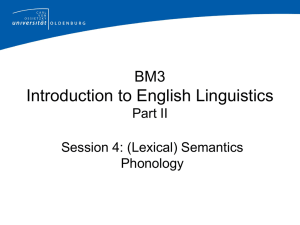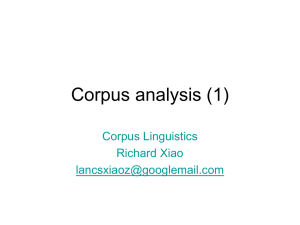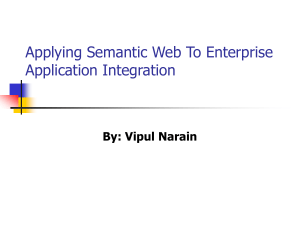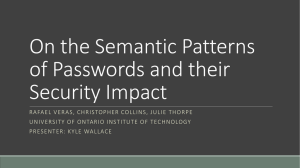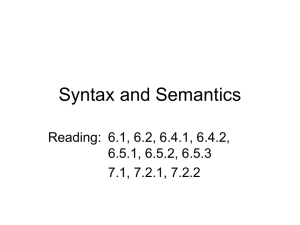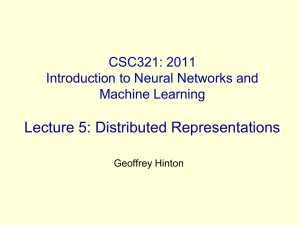Towards an Understanding of Semantic Prosody
advertisement
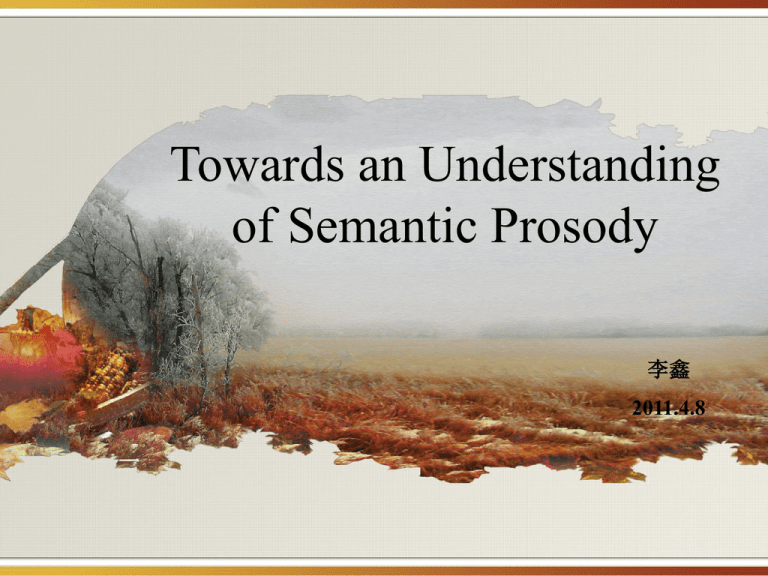
Towards an Understanding of Semantic Prosody 李鑫 2011.4.8 You shall know a word by the company it keeps. —J. R. Firth Significance • Theoretically: SP is a fundamental aspect of the idiom or phraseological principle of language production and interpretation, in particular providing convincing evidence of how elements of meaning “hunt in packs” (i.e. the co-selection principle). • Practically: an awareness of SP can be invaluable for the translator and language learner in distinguishing among items considered to be synonyms or translation equivalents. E.g. “Your kind help caused my success in the exam.” “I would like to thank my supervisor for his persistent help and advice.” • (Morley & Partington 2009) Various definitions • Semantic prosody is the “consistent aura of meaning with which a form is imbued by its collocates” (Louw, 1993: 157)关键词项的典型搭配词在其语境中营造起的语义 氛围 • A semantic prosody is attitudinal, and on the pragmatic side of the semantics/pragmatics continuum. …It expresses something close to the “function” of the item – it shows how the rest of the item is to be interpreted functionally. Without it, the string of words just “means” – it is not put to use in a viable communication. (Sinclair, 1996: 87-88) • Semantic prosody is “the spreading of connotational colouring beyond single word boundaries”. (Partington, 1998: 68) • A semantic prosody refers to a form of meaning which is established through the proximity of a consistent series of collocates, often characterisable as positive or negative, and whose primary function is the expression of the attitude of its speaker or writer towards some pragmatic situation. (Louw, 2000: 56) • Semantic prosody refers to POS/NEG connotation as well as more complex attitudinal connotations, affecting both single words and larger units of meaning such as phrases, i.e. concerns both ‘traditional’ connotation (said to relate to single words) and ‘prosodic’ connotation (connotation that is “distributed prosodically across a textual sequence”) (Bednarek, 2008) Origin • The term “semantic prosody” was first used in print and introduced to the public by Louw (1993) who credited Sinclair with its coinage (“personal communication 1988”). • The term “prosody” was borrowed from Firth who used it, as in “prosodic phonology”, to refer to phonological coloring which was capable of transcending segmental boundaries. E.g. Amen: the vowels are imbued with a nasal quality because of their proximity to the nasals m and n. (Louw, 1993) • The concept of SP was developed by post-Firthian corpus linguists -- Sinclair, Louw, Stubbs, Partington and Hunston. Clarification • Q1: Is SP the same as connotation? – Semantic prosodies are not merely connotational. Whereas knowledge of connotations is often a form of schematic knowledge of repeatable events, semantic prosodies are more strictly functional or attitudinal. (Louw, 2000) – Connotation is a feature of a single word/item, while SP resides in the collocational patterns of items in a text. Connotation is more evident and less hidden/sutble than SP. (Morley & Partington, 2009) – E.g. wedding, funeral v.s. happen/build up • Q 2: What’s the relationship between semantic prosody and semantic preference? – Sinclair’s model of ELU (extended lexical units): The units of meaning are somewhere between words and sentences. “So strong are the co-occurrence tendencies of words, word classes, meanings and attitudes that we must widen our horizons and expect the units of meanings to be much more extensive and varied than is seen in a single word.”(Sinclair, 1996) A compound lexical item/ELU with four parameters--from concrete to abstract: collocation, colligation, semantic preference and semantic prosody E.g. “the naked eye” Collocation: N-1: with, to; N-2: see, visible, invisible; N-3: evident, undetectable Colligation: preposition+the naked eye Semantic preference: visibility Semantic prosody: difficulty (through a larger context) Compound lexical item/ELU: visibility+preposition+the naked eye – Semantic preference is more concrete and collocationally detectable than semantic prosody. Semantic preference relates the node item to another item from a particular semantic set, while semantic prosody is an abstraction from wider stretches of text. – They interact with each other: S preference, contributes powerfully to building S prosody; S prosody dictates the general environment which constrains the preferential choices of the node item. (Partington, 2004) E.g. undergo • Semantic preference: medicine (treatment, hysterectomy, brain surgery etc.), tests (examinations, training) and change (dramatic changes, a historic transformation among others); involuntariness (must, forced to and required to) • Semantic prosody: NEG • Q 3: Is SP simply a two-term system as either POS or NEG? – Stubbs: NEG; POS; neutral/mixed prosody (Stubbs, 1996) – After some initial confusion, corpus linguists have reached a general agreement in appreciating the POSNEG distinction at the heart of the notion of SP. The POS-NEG distinction is the essential simplicity at the heart of a complex system. (Partington, 2004) e.g. place—informal invitation (Sinclair, 1996) – Caution: NEG collocates don’t necessarily result in NEG SP. e.g. alleviate, heal, relieve • Q 4: Is SP a lexical feature or a discourse function? – 1. Two ways of viewing SP: the lexical priming perspective vs. the discoursal perspective SP is associated with the lexical item and expresses itself in patterns of co-occurrence. Lexical items carry with them a set of suggestions on how to use them, on how they normally interact with other items—they have “primings” (Hoey). Among these is the SP. 2. From another perspective, SP is definable as the evaluative intent of the speaker, i.e. the attitude s/he has to the topic in any individual text fragment. The overall SP choice dictates the lower choices of phraseology and lexis. E.g. speaker’s NEG attitude-- wish to say a certain situation is bad because it is dangerous— “fraught with” danger, not “brimming with” danger c.f. I choose “fraught with” because my communicative competence informs me that its SP primings allow it to be used in this way. (Morley & Partington, 2009) • Q 5: Should the term SP be replaced by discourse prosody (Stubbs) or pragmatic prosody? – Stubbs argues that, since prosodies express speaker attitude, we should avoid using the term semantic, which relates to aspects of meaning which are independent of speakers. However, prosodies are independent of individual speakers, otherwise communication would be impossible. Thus the potential of an item for engaging in the expression of favourable or unfavourable evaluation is part of its basic communicative function. (Partington, 2004) Approaches and findings • Data-based approach: colligation • Data-driven approach: node, span and collocate; statistical tests of collocational strength (MI score, T score, Z score, etc.) • Integrated approach – 卫乃兴. (2002). 语义韵研究的一般方法. 外语教学与研究(04), 300-307. Author Negative prosody Sinclair (1991, 1996) BREAK HAPPEN SET in out Louw (1993, 2000) utterly bent on build of v. ed END up verbing GET oneself Stubbs 2001) (1995, 1996, teenager(s) CAUSE signs of Positive prosody Neutral/mixed prosody place BUILD up a PROVIDE career Author Negative prosody Partington (1998) COMMIT PEDDLE/peddler dealings Hunston 2007) (2002, Positive prosody Neutral/mixed prosody SIT through persistent (Xiao & McEnery, 2006) Consequence(s) cause (卫乃 兴 , 2002a, 2002b, 2006) Cause Incur Incidence of Commit (Xiao & McEnery, 2006) Consequence(s) cause Result outcome career Result outcome Consequently 结果 Probability of effect Consequently 结果 Implications • SP is a controversial and elusive concept, but it is crucial to our understanding of lexical behaviors and discourse meanings, hence the significance of research. • A working definition is needed before we conduct any serious empirical research on SP. • More SP studies about languages other than English are yet to be conducted. • Investigating SP on translated language? Reference 1. 2. 3. 4. 5. 6. 7. 8. 9. 10. 11. 12. Bednarek, M. (2008). Semantic preference and semantic prosody re-examined. Corpus Linguistics and Linguistic Theory, 4(2), 119-139. Louw, B. (1993). Irony in the text or insincerity in the writer? The diagnostic potential of semantic prosodies. In M. Baker, G. Francis & E. Tognini-Bonelli (Eds.), Text and Technology (pp. 157-176). Amsterdam: Benjamins. Louw, B. (2000). Contextual prosodic theory: Bringing semantic prosodies to life, Words in Context: A tribute to John Sinclair on his retirement. (pp. 48-94). Birmingham: University of Birmingham. Morley, J., & Partington, A. (2009). A few Frequently Asked Questions about semantic or evaluative prosody. International journal of corpus linguistics, 14(2), 139-158. Partington, A. (1998). Patterns and meanings. Amsterdam and Philadelphia: Benjamins. Partington, A. (2004). " Utterly content in each others company": Semantic prosody and semantic preference. International journal of corpus linguistics, 9(1), 131-156. Sinclair, J. (1996). The search for units of meaning. Textus, 9(1), 75-106. Stubbs, M. (1996). Text and corpus analysis. Oxford: Blackwell. Xiao, R., & McEnery, T. (2006). Collocation, semantic prosody, and near synonymy: A crosslinguistic perspective. Applied Linguistics, 27(1), 103-129. 卫乃兴. (2002a). 语料库数据驱动的专业文本语义韵研究. 现代外语, 25(002), 165-175. 卫乃兴. (2002b). 语义韵研究的一般方法. 外语教学与研究(04), 300-307. 卫乃兴. (2006). 基于语料库学生英语中的语义韵对比研究. 外语学刊(05), 50-54+112.
